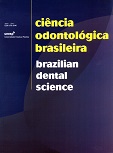Concentração fungicida mínima das soluções de clorexidina e hipoclorito de sódio sobr Candida Albicans
DOI:
https://doi.org/10.14295/bds.2008.v11i2.457Resumo
A clorexidina e o hipoclorito de sódio são agentes irrigantes comumente utilizados na Endodontia em diferentes concentrações.A concentração fungicida mínima destas soluções sobre leveduras do gênero Candida, que são microrganismos freqüentemente associados a infecções endodônticas secundárias e/ou persistentes, é raramente discutida na literatura.
Desta forma, a proposta deste estudo foi avaliar a concentração fungicida mínima das soluções irrigadoras clorexidina e hipoclorito de sódio sobre cepas de C. albicans. Foram avaliados 21 isolados clínicos e 1 cepa padrão de C. albicans frente às seguintes soluções: G1) NaOCl 5,25% e G2) clorexidina 2%, determinando-se a concentração fungicida mínima (CFM). Foram realizadas 12 diluições seriadas das soluções, em placas de microtitulação de 96 poços. Em seguida, foram acrescentados 100 μL de suspensão padronizada da levedura de cada cepa de C. albicans nos poços das placas. Os testes foram realizados em duplicata. As placas foram incubadas a 37ºC por 24 h e, após, foram realizadas semeaduras em ágar Sabouraud dextrose para determinar a CFM. Os resultados demonstraram que no G1 (NaOCl), a CFM foi 0,04% para 68,2% das cepas e entre 0,02% e 0,01% para 22,7% das cepas. No grupo G2 (clorexidina), a CFM foi entre 0,0037% e 0,0018% para 72,72% das cepas. Assim, pôde-se concluir que ambas soluções apresentaram efetiva atividade fungicida sobre C. albicans, sendo que a CFM da solução de clorexidina foi menor que a do hipoclorito de sódio para todas as cepas avaliadas.
Downloads
Downloads
Publicado
Como Citar
Edição
Seção
Licença
TRANSFERÊNCIA DE DIREITOS AUTORAIS E DECLARAÇÃO DE RESPONSABILIDADE
Toda a propriedade de direitos autorais do artigo "____________________________________________________________________" é transferido do autor(es) para a CIÊNCIA ODONTOLÓGICA BRASILEIRA, no caso do trabalho ser publicado. O artigo não foi publicado em outro lugar e não foi submetido simultaneamente para publicação em outra revista.
Vimos por meio deste, atestar que trabalho é original e não apresenta dados manipulados, fraude ou plágio. Fizemos contribuição científica significativa para o estudo e estamos cientes dos dados apresentados e de acordo com a versão final do artigo. Assumimos total responsabilidade pelos aspectos éticos do estudo.
Este texto deve ser impresso e assinado por todos os autores. A versão digitalizada deverá ser apresentada como arquivo suplementar durante o processo de submissão.




























